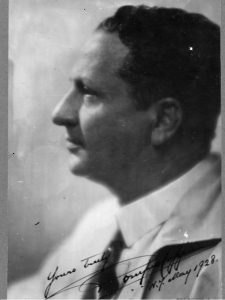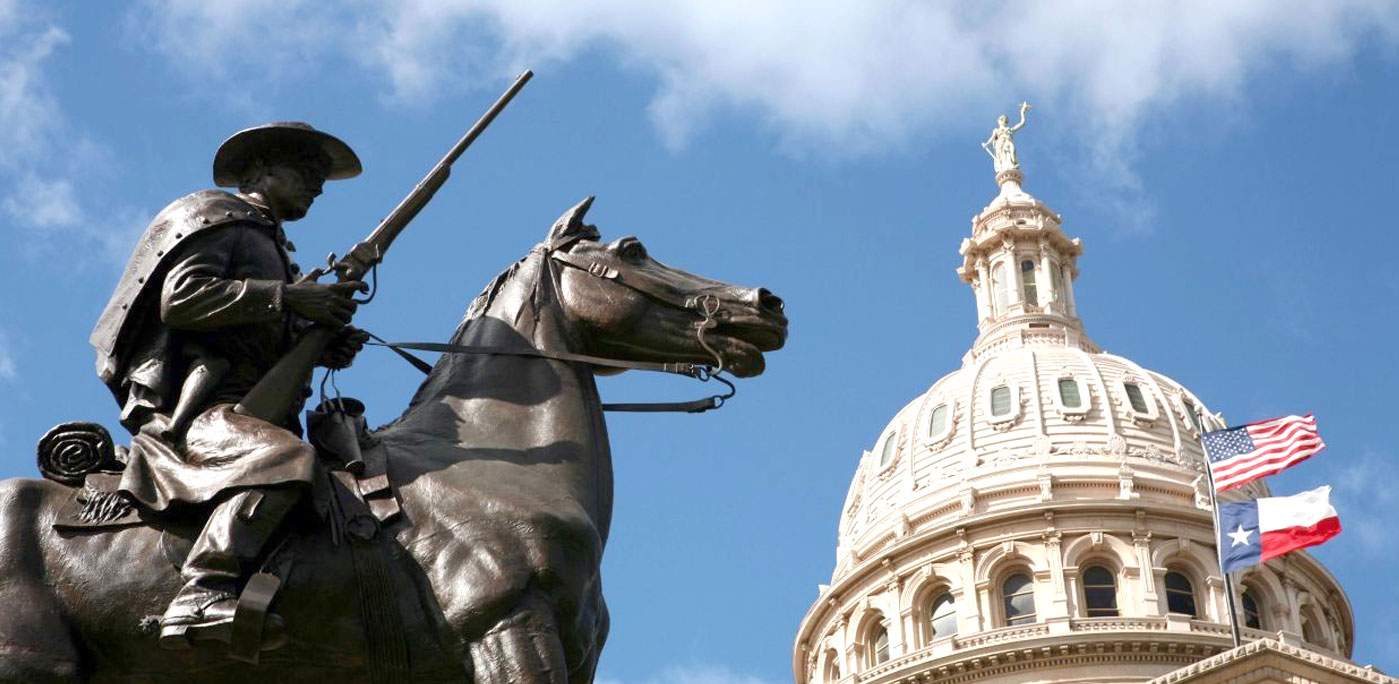But what he had not anticipated nor planned for was the addition of an assistant. And a girl at that. Miss Waldine Tauch of Brady, from Texas, was a remarkably talented young girl of 18 years, beautiful and ambitious, yet devoted to her troubled family. Like Coppini, she had endured a childhood rife with stress from a bitterly jealous and unstable mother and a father who never saw his desire to be an artist fulfilled. Her salvation came when the ladies of a local club noted her prodigious talents and wrote to Coppini, beseeching he take her as a student.
A young girl was the last prototype the Sculptor had in mind – because this was a man’s world that required strength, engineering skill, persistence, and grueling physical effort – certainly a female could not manage such things! Waldine proved to be these things and more; her life was one of devotion to the Coppinis. She became known as their foster daughter and served as top assistant throughout Pompeo’s life, furthering his visions even after his death, all the while earning her place in history as a renowned artist.
The advent of World War I brought a dramatic decrease in commissions for Coppini – funding evaporated as the country garnered all resources for war. After five years in the Madeleine Terrace house, the expenses of a vast home, lavish parties, and copious art supplies became unsustainable. Coppini sold the house and decided to relocate to Chicago, thinking a larger, more cosmopolitan city could utilize his Texas-sized talents.

Chicago had not escaped the war-time drain, however, and Coppini found himself in similar dire straits, just at a higher latitude. But right on cue, his adopted state of Texas brought deliverance, galloping in like a cinema hero to save the day, in the form of a bonafide cowboy by the name of Gus Noyes.
Gus was a hardworking, no nonsense rancher who’d found great wealth working livestock in the rough and tumble country of West Texas. He was also a grief-stricken father, inconsolably distraught over the untimely death of his 20-year-old son Charlie who’d been killed in a horse accident. Summoning Coppini to his ranch, Noyes wanted a life size statue of his son and favorite horse cast in bronze with the intent to place it on the spot where the youth had died. Coppini notes in his autobiography that Noyes was a man of hidden deep in a veil sorrow, a man who appeared to be of little means – had he been duped into a commission that was nothing more than a deep-seated wish for some kind of restoration of life for which no funds could be offered?
He returned to his Chicago studio, a few faded photos in hand, and began the commission. Even the boy’s saddle, bridle, and boots were shipped for the sculptor’s use. This particular work seemed to reach deep within Pompeo, finding its way past the typical pretentious bravado. He trudged two hours in a blizzard to reach his studio, fretting over the condition of the almost completed cast. Frozen, the clay cast crumbled into gray dust as the room warmed, settling lifeless on the studio floor. Coppini immediately began again, working feverishly on the piece, and even summoned the Noyes to Chicago to evaluate the boy’s face. “Please do not touch the face again, for that is our Charlie,” came the poignant reply.
Upon completion, the statue was erected in Ballinger, Texas; the Noyes had relocated to Florida, unable to bear life in Texas. The commission was paid, but at a reduced price offered by Coppini. As the story goes, on his trip to the ranch Coppini accompanied Noyes to the site of the accident. Overcome with grief, Noyes all but collapsed. Coppini had previously decided his price would be $24,000., but so touched by the father’s grief, he later that day quoted $18,000. Noyes gratefully accepted, shook hands, then added, “I was prepared to pay twice that amount!”
Bigger and grander commissions, at least by common definition, came Coppini’s way, each with a story laced in captivating melodrama, each adding a bold exclamation mark to the landscape of Texas. Why even a baffling mystery of twenty-four missing statues given to the University of Texas, including his tragic “Victims of the Galveston Flood”, rests unsolved to this day. Donated by Pompeo in 1914 — “As I feel Texas to be my own state, you shall always have first opportunity” — the statues were promptly put to bed in a Science building basement. In 1918, a cache of journalism students stumbled upon the treasures: “He has given the University a princely gift”, an article exclaimed, “It must be admitted that we accorded it a beggarly reception.” At their insistence, the statues were displayed and all was well until a short time later in 1919 when once again, the statues vanished and the trail went cold. A modern-day Sherlock Holmes by the name of John Bernardoni is doggedly at work to get to the bottom of this enigma — “I get tenacious when I’m passionate, and I’m very passionate about this.” – but hasn’t uncovered much more than ghostly vapors thus far.
Of the many Coppini commissions that proudly punctuate the vastness of Texas, some of the more notable include The University of Texas Littlefield Fountain in Austin; the Alamo centograph, “The Spirit of Sacrifice” in San Antonio, along with the allegorical bronze doors on the Scottish Rite Temple; the Sul Ross statue on Texas A&M University Campus; the Sam Houston memorial at Houston’s grave; a grouping of Texas heroes in Dallas which includes Italian Prospero Gernardi, a hero of the Battle of San Jacinto; Coppini’s own grave statuary; and many others worthy of recognition but too numerous to include. A few other locales are also proud owners of Coppini works, including Washington, D.C., New Jersey, Mexico City, and happily so…Italy.
And Italy did take note of this son from Lombardy’s overall accomplishments, I was glad to discover, honoring him with the Commendatore of the Order of the Crown of Italy (1931) for his contributions to American art. Bravo, Pompeo.
With the need to brush off a bit guilt and satisfy a lot of curiosity, I made a recent pilgrimage to Austin and San Antonio to meet (or reacquaint myself) up close and personal with a number of these works – and yes, they are realism magnified in bronze or granite, not unlike the splendid works in marble I’ve laid eyes upon throughout Italy. I beheld statuary offering a gamut of emotion — some imperturbable and others impassioned, some fiery and others extolling maternal peacefulness, some telling epic heroic tales and others celebrating the every day. All, however, were exquisite creations. I understood all the fuss those many years ago. And I felt sadness at what I perceived as works now un — or at least under— appreciated.
I found my way to Coppini’s San Antonio studio, known as The Coppini Academy of Fine Art, a creative space and quasi-museum with the mission “to encourage worthy accomplishment in the world of art”. It’s an unassuming building of 1937 art deco design situated on a quiet residential street. I was disappointed to not have the opportunity to step inside and snoop around, maybe ask a few questions here and there. Despite posted open hours, the Academy doors were locked.
I did wander around the small yard enclosed by weathered wooden fences that blocked out the ordinary of neighbors, and enjoyed the company of four smallish but beautiful works scattered about. These diminutive Coppini’s were as magnificent and emotion provoking as the larger-than-life creations I’d viewed earlier. I gazed, touched, pondered, and smiled; it was almost like visiting with old friends.
And as I had in each location where possible, I traced with my finger the letters so simply carved on a relief resting on the Academy wall, boldly announcing the proud, driven, lavish creator, this Pompeo Coppini – Sculptor. His vibe lives on.





























